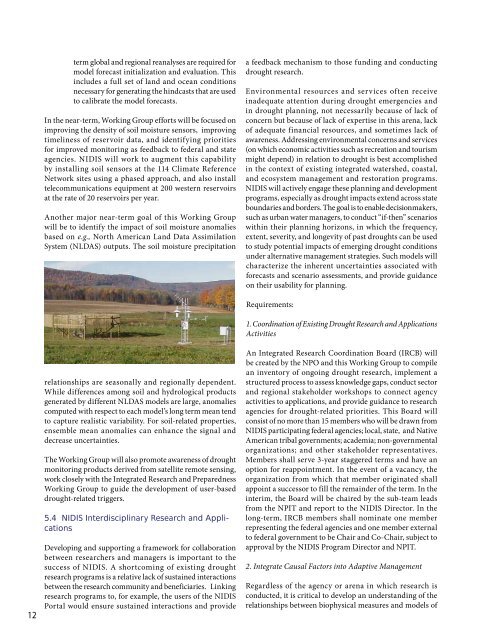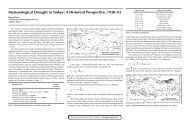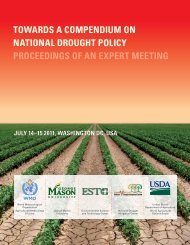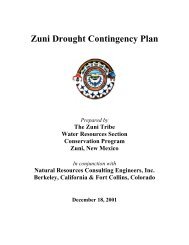Table of Contents - National Drought Mitigation Center - The ...
Table of Contents - National Drought Mitigation Center - The ...
Table of Contents - National Drought Mitigation Center - The ...
Create successful ePaper yourself
Turn your PDF publications into a flip-book with our unique Google optimized e-Paper software.
12<br />
term global and regional reanalyses are required for<br />
model forecast initialization and evaluation. This<br />
includes a full set <strong>of</strong> land and ocean conditions<br />
necessary for generating the hindcasts that are used<br />
to calibrate the model forecasts.<br />
In the near-term, Working Group efforts will be focused on<br />
improving the density <strong>of</strong> soil moisture sensors, improving<br />
timeliness <strong>of</strong> reservoir data, and identifying priorities<br />
for improved monitoring as feedback to federal and state<br />
agencies. NIDIS will work to augment this capability<br />
by installing soil sensors at the 114 Climate Reference<br />
Network sites using a phased approach, and also install<br />
telecommunications equipment at 200 western reservoirs<br />
at the rate <strong>of</strong> 20 reservoirs per year.<br />
Another major near-term goal <strong>of</strong> this Working Group<br />
will be to identify the impact <strong>of</strong> soil moisture anomalies<br />
based on e.g., North American Land Data Assimilation<br />
System (NLDAS) outputs. <strong>The</strong> soil moisture precipitation<br />
relationships are seasonally and regionally dependent.<br />
While differences among soil and hydrological products<br />
generated by different NLDAS models are large, anomalies<br />
computed with respect to each model’s long term mean tend<br />
to capture realistic variability. For soil-related properties,<br />
ensemble mean anomalies can enhance the signal and<br />
decrease uncertainties.<br />
<strong>The</strong> Working Group will also promote awareness <strong>of</strong> drought<br />
monitoring products derived from satellite remote sensing,<br />
work closely with the Integrated Research and Preparedness<br />
Working Group to guide the development <strong>of</strong> user-based<br />
drought-related triggers.<br />
5.4 NIDIS Interdisciplinary Research and Applications<br />
Developing and supporting a framework for collaboration<br />
between researchers and managers is important to the<br />
success <strong>of</strong> NIDIS. A shortcoming <strong>of</strong> existing drought<br />
research programs is a relative lack <strong>of</strong> sustained interactions<br />
between the research community and beneficiaries. Linking<br />
research programs to, for example, the users <strong>of</strong> the NIDIS<br />
Portal would ensure sustained interactions and provide<br />
a feedback mechanism to those funding and conducting<br />
drought research.<br />
Environmental resources and services <strong>of</strong>ten receive<br />
inadequate attention during drought emergencies and<br />
in drought planning, not necessarily because <strong>of</strong> lack <strong>of</strong><br />
concern but because <strong>of</strong> lack <strong>of</strong> expertise in this arena, lack<br />
<strong>of</strong> adequate financial resources, and sometimes lack <strong>of</strong><br />
awareness. Addressing environmental concerns and services<br />
(on which economic activities such as recreation and tourism<br />
might depend) in relation to drought is best accomplished<br />
in the context <strong>of</strong> existing integrated watershed, coastal,<br />
and ecosystem management and restoration programs.<br />
NIDIS will actively engage these planning and development<br />
programs, especially as drought impacts extend across state<br />
boundaries and borders. <strong>The</strong> goal is to enable decisionmakers,<br />
such as urban water managers, to conduct “if-then” scenarios<br />
within their planning horizons, in which the frequency,<br />
extent, severity, and longevity <strong>of</strong> past droughts can be used<br />
to study potential impacts <strong>of</strong> emerging drought conditions<br />
under alternative management strategies. Such models will<br />
characterize the inherent uncertainties associated with<br />
forecasts and scenario assessments, and provide guidance<br />
on their usability for planning.<br />
Requirements:<br />
1. Coordination <strong>of</strong> Existing <strong>Drought</strong> Research and Applications<br />
Activities<br />
An Integrated Research Coordination Board (IRCB) will<br />
be created by the NPO and this Working Group to compile<br />
an inventory <strong>of</strong> ongoing drought research, implement a<br />
structured process to assess knowledge gaps, conduct sector<br />
and regional stakeholder workshops to connect agency<br />
activities to applications, and provide guidance to research<br />
agencies for drought-related priorities. This Board will<br />
consist <strong>of</strong> no more than 15 members who will be drawn from<br />
NIDIS participating federal agencies; local, state, and Native<br />
American tribal governments; academia; non-governmental<br />
organizations; and other stakeholder representatives.<br />
Members shall serve 3-year staggered terms and have an<br />
option for reappointment. In the event <strong>of</strong> a vacancy, the<br />
organization from which that member originated shall<br />
appoint a successor to fill the remainder <strong>of</strong> the term. In the<br />
interim, the Board will be chaired by the sub-team leads<br />
from the NPIT and report to the NIDIS Director. In the<br />
long-term, IRCB members shall nominate one member<br />
representing the federal agencies and one member external<br />
to federal government to be Chair and Co-Chair, subject to<br />
approval by the NIDIS Program Director and NPIT.<br />
2. Integrate Causal Factors into Adaptive Management<br />
Regardless <strong>of</strong> the agency or arena in which research is<br />
conducted, it is critical to develop an understanding <strong>of</strong> the<br />
relationships between biophysical measures and models <strong>of</strong>








